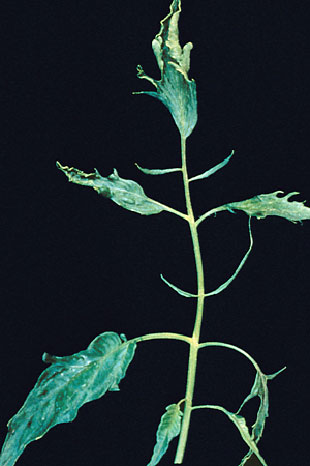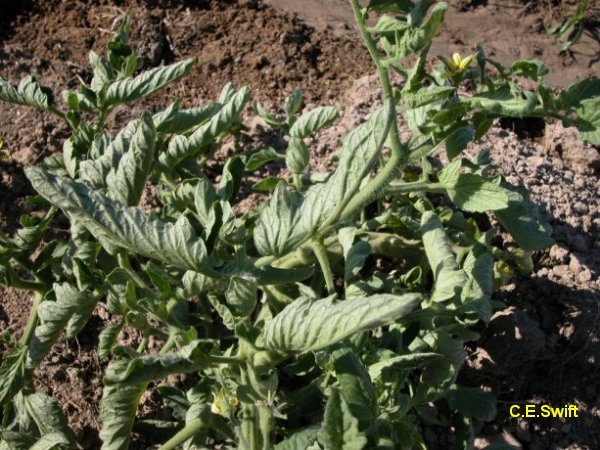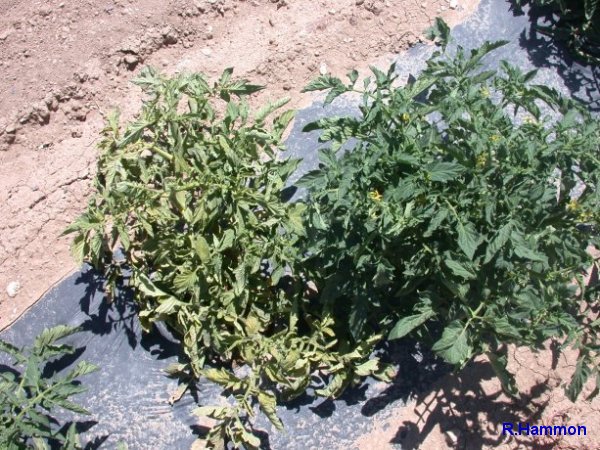 Curly Top Virus - August 1, 2012 Jeff Schalau, Agent, Agriculture & Natural Resources University of Arizona Cooperative Extension, Yavapai County It appears that curly top virus (CTV) has again impacted vegetable crops across Yavapai County this summer. I have visited gardens or received reports of CTV from Prescott, Prescott Valley, Camp Verde, and Cottonwood. The virus has been reported primarily on tomatoes, but I have observed symptoms on green been, peppers, and squash. For years, CTV has been an issue in the Verde Valley. The first records of CTV in our area come from Camp Verde growers in the 1860s and it probably impacted Native American farmers prior to that time. This year, I have heard that it has impacted about 50% of the Verde Valley tomato crop. Viral plant diseases are difficult to manage as there are complex interactions between the pathogen (virus), hosts (crop plants), vector (organism that transmitted the virus), and environment. Because of these uncertainties, it is difficult for vegetable growers to adopt CTV management strategies and know how and when to apply them. CTV is found across the western U.S. and is transmitted to crop plants by the beet leafhopper (Circulifer tenellus). The virus survives from season to season on weeds: usually those in the mustard and goosefoot (including lambs quarter and Russian thistle) families. Beet leafhoppers feed on weeds in the early spring and transfer the virus to crops including tomatoes, beets, peppers, squash, beans, cucurbits (squash, melons, and cucumbers), spinach, potatoes, and other crops. After the beet leafhopper initially ingests plant cell sap containing the virus, the virus incubates in the leafhopper for 4 to 21 hours before it can be transmitted. Once incubated, the virus is transmitted to other host plants by the leafhopper. The disease is transported within the plant through the phloem tissue and symptoms usually begin to appear after 24 hours in hot temperatures and more slowly in cooler temperatures. When a susceptible plant becomes infected, leaves become puckered and stunted. Tomato leaves curl and roll upward and the main leaf petiole curves downward. In time, the leaves also become leathery, veins turn a purplish color and the interveinal leaf area turns yellowish. Infected plants will not recover and eventually the plant stops growing and dies. Infected tomatoes may ripen even when immature however, edible size fruit are likely to be bitter. Once you observe definite symptoms, it is best to pull out the plant and destroy it. CTV cannot overwinter in the soil; it must remain in a living plant. Plants cannot be infected by planting them in soil where infected plants grew last year or by use of compost from infected plants. CTV is not transmitted in plant seeds, but can be spread in potato “seed” pieces. Similarly, the virus is not spread from generation to generation in leafhopper eggs. Spraying insecticides on tomato plants is not an effective leafhopper control strategy. In fact, leafhoppers do not prefer tomatoes as a food source. They inadvertently land on the plant, feed, and then move on. Plant pathologists say there is little secondary spread of CTV from one crop plant to the next within a field. While I’d like to believe them, I and many growers feel we have observed evidence the disease can be spread from crop plant to crop plant in the field. One preventative strategy is to control weeds adjacent to cropped areas before transplants are planted. This may be of little value since beet leafhoppers are known to fly long distances. Fine mesh barriers (floating row cover or other horticultural fabric) could prove to be a viable management strategy to prevent leafhoppers from feeding. The most critical time to have the plants covered would be early to mid-season. Most growers in the Verde Valley keep several replacement plants in containers to fill in where CTV infected plants have been removed. A few years ago, we experimented with planting the four CTV resistant tomato varieties: Roza, Rowpac, Columbia, and Saladmaster. Most of the gardeners and growers concluded that these were not the best tasting tomatoes and went back to their favorite non-CTV resistant varieties. In addition, I have observed another virus on tomato which I believe is cucumber mosaic virus (CMV). CMV is vectored by aphids and the symptoms include “shoestringing” of leaves. Recommendations are the same – remove infected plants and destroy them. I have included photos of CTV and CMV as well as links to publications on the web version of this column (see web address below). Follow the Backyard Gardener on Twitter – use the link on the BYG website. If you have other gardening questions, call the Master Gardener help line in the Camp Verde office at 928-554-8999 Ext. 3 or e-mail us at cottonwoodmg@yahoo.com and be sure to include your name, address and phone number. Find past Backyard Gardener columns or provide feedback at the Backyard Gardener web site: http://cals.arizona.edu/yavapai/anr/hort/byg/. Publication: Curly Top Virus, New Mexico State University Cooperative Extension Service, http://aces.nmsu.edu/pubs/_h/h-106.pdf Publication: Recognizing Tomato Problems, Colorado State University Extension http://www.ext.colostate.edu/pubs/garden/02949.html  Close up photo of curly top virus symptoms on tomato, Colorado State University Extension, from: http://www.coopext.colostate.edu/TRA/PLANTS/curlytopvirus.shtml.  Whole plant photo of curly top virus symptoms on tomato, Colorado State University Extension, from: http://www.coopext.colostate.edu/TRA/PLANTS/curlytopvirus.shtml.  Leaf with "shoestring" symptoms of cucumber mosaic virus on tomato, University of Arkansas University, from: http://plantpathology.uark.edu/3636.htm. |